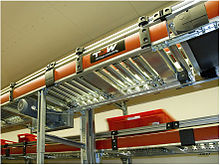Roller conveyor
Roller conveyors are stationary systems within conveyor technology in which objects are transported using an arrangement of rollers ( roller transfer ). Roller conveyor distribution and storage are en example for sorting, general cargo and the picking of goods used.
The objects to be conveyed can roll down independently on inclined roller conveyors. However, more flexible walking routes can be achieved through motorized transport.
Depending on the weight of the goods to be ejected, the rollers are made of steel or plastic and can have different widths. Narrow rolls are called disc rolls or rolls. Several rollers attached to one axis (regardless of whether they are next to each other or one behind the other) form disc or roller conveyors. Large roller conveyors are also known as roller carpets .
Roller lift table
Belts running parallel to each other (two or more), between which cylindrical rollers are attached, form the so-called roller lifting table. In the initial state, the rollers used are below the so-called conveying level of the belts (the conveying level only means that the transported goods are higher than the rollers, so the goods can be conveyed over them without problems, because they are not can offend). To eject the goods, the rollers are lifted above the conveyor level so that the goods lying on them can be ejected from the conveyor at an angle of 90 °. Since there are smaller gaps between the belts and the rollers, smaller packages / goods are difficult to transport within this roller conveyor system. The transport system of the belt conveyor, which is used in the roller lift table, finds u. a. Used for goods around 50 kg and has a sorting capacity of 2,000 parts per hour.
Friction roller conveyor and accumulation roller conveyor
Friction and accumulation roller tracks are used to move objects by means of a motor drive. In order not to damage sensitive objects if their movement is inhibited, but the rollers continue to run, friction roller conveyors are equipped with a friction drive that slips when a certain torque is exceeded.
Internal friction: Friction rollers are connected to the driven shaft via a friction lining. Depending on the weight of the material to be conveyed, there is a corresponding friction and power transmission.
External friction: The drive is connected to the roller via a slip clutch, depending on the setting of the slip clutch, more or less force is transmitted regardless of the weight of the material being conveyed.
Friction roller conveyors are usually easy to control. With uninterrupted drive, the conveyed item moves until it hits a stopper or another item. In the event of a jam, the goods to be conveyed are lined up close together on the roller conveyor.
Compared to roller transport driven by gravity, friction and accumulation roller conveyors exert a significantly stronger force on the front objects in the event of a jam, which increases with the length of the jam. It may therefore be necessary to use a mechanism to reduce the dynamic pressure for longer lengths. A separation mechanism (stopper) is also required in order to be able to remove the first item to be conveyed without all other items following.
Roller rails and swivel roller sorters
Roller strips are made up of a number of small and tilted rollers, which are located between the leading roles and can be lifted out of the transport plane to smuggle the goods from the tape.
Pivoting roller sorters are equipped with adjustable rollers that eject the goods on both sides (special form of roller bar: pivoting roller sorter). If the goods are aligned in advance in the direction of discharge, this ensures a quick and safe delivery.
Roller table
In rolling mills , roller conveyors are used to transport individual slabs between the processing devices . Such conveying devices are usually referred to as roller tables and transport individual loads of up to 30 tons, in individual cases even more. In hot rolling mills, the glowing slabs must not remain on individual rolls, as these would otherwise overheat. Roller tables in rolling mills sometimes extend over a kilometer. An overview of the transport routes is recorded there in roller table plans or roller plans . Continuous systems for the production of sheet metal strips ( coils ) are called strip systems .
See also
swell
- Günthner, Willibald A. and Heptner, Klaus: Technical innovations for logistics, Huss Verlag, Munich, 2007
Web links
Individual evidence
- ↑ Archived copy ( memento of the original dated November 24, 2012 in the Internet Archive ) Info: The archive link was inserted automatically and has not yet been checked. Please check the original and archive link according to the instructions and then remove this notice.
- ↑ Archived copy ( Memento of the original from March 4, 2016 in the Internet Archive ) Info: The archive link was inserted automatically and has not yet been checked. Please check the original and archive link according to the instructions and then remove this notice.


